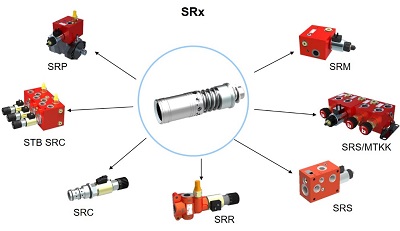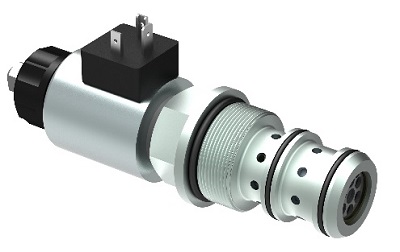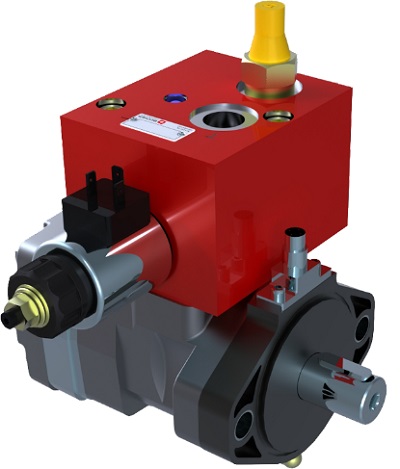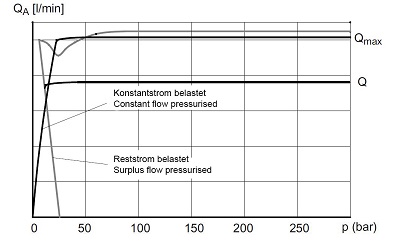In hydraulic systems, proportional flow control valves ensure that flow rates remain virtually constant. In doing so, they have to meet a large number of performance criteria that extend beyond their core function.

According to engineers at Bucher Hydraulics, manufacturers and operators of mobile machines are increasingly placing a special emphasis on energy efficiency. Flow control valves in particular should have a compact design and be easy to incorporate into complex hydraulic systems regardless of the installation situation, saving both time and money. These flow control valves withstand harsh environmental conditions and corrosive attack without difficulty, as they can be supplied with protective coatings such as a zinc-nickel coating on all surfaces (> 720 hr, ISO 9227 NSS). Manufacturers of mobile machines thus benefit from efficient, precise, durable and robust components that offer a high power density.
Minimizing pressure losses
Series SRx electrically operated proportional flow control valves from Bucher Hydraulics reportedly meet these far-reaching requirements. Depending on the particular model, they are suitable for constant flow rates between 0.3 and 80 l/min (0.08 to 21.1 gpm) at inlet pressures up to 315 bar (5,076 psi). They are designed as 3-way valves but, under certain conditions, can also be used as 2-way valves by simply plugging the surplus flow port.
Another advantage is that these flow control valves work reliably with a control ΔP of only 7 bar (101.5 psi), and with just 5 bar (72.5 psi) in a special version. These values are significantly below the 12 to 15 bar (174 to 218 psi) customary in the industry. The extra pump power that is typically required is thus reduced by up to 5% during operation.

And an all-important advantage with all SRx 3-way flow control valves is that the surplus flow port can be pressurized. This means they can be used for other, secondary applications — for an auxiliary drive, for example. The flow control valves are also equipped for non-typical situations. For instance, they have an easily adjusted emergency override.
Universal integration
The SRRB series of proportional flow control valves can be readily integrated into almost any hydraulic system. This model is particularly compact and designed for direct mounting in hydraulic lines. A compelling feature is its outstanding power density. The main markets for these flow control valves are in agricultural and municipal machines.
They work reliably even under harsh environmental conditions, require only minimal installation space and can be fitted at any point in the piping system. This proves to be a distinct advantage where a large number of individual hydraulic drives are distributed throughout a machine.
Equipment manufacturers enjoy similar advantages with the compact SRM series of monoblock valves. They are also extremely stable and reliable thanks to the control assembly being integrated directly into the main body. The advantage is that several flow control valves, as well as special features such as directional control valves for reversing the rotation of connected hydraulic motors, can be integrated into the compact housing while minimizing space requirements. Especially in the area of construction machines, such highly integrated systems can be created for working pressures of up to 350 bar. In close cooperation with customers, Bucher Hydraulics specialists can optimize configurations for medium and large series.

Modular design
When machine manufacturers need a highly adaptable hydraulic solution for their various systems, they tend to prefer to use modular proportional flow control valves. The company’s SRC cartridge-type flow control valves offer advantages when it comes to flexible installation. The standard cartridge valves can be fitted into valve blocks easily and quickly. They can also be exchanged just as simply. Lightweight aluminum blocks adapted to the customer’s needs are preferred here.
On one hand, using cartridge valves minimizes maintenance and servicing costs when replacing individual valves. It is not necessary to replace the complete block, only the cartridge valve concerned. On the other, it significantly reduces warehousing costs for manufacturers as well as for distributors and service partners.
The control assembly of the SRx can also be installed in a slim valve body. As sectional valves (SRS), these can then be combined and assembled together to form a control block. In this way, valve blocks can be designed to meet individual requirements, and the design is adaptable and has a minimal logistics impact for spare parts. This is a particular benefit to manufacturers of municipal vehicles and universal multi-attachment vehicles, which are equipped for a wide range of applications.

Decentralized arrangements
Bucher Hydraulics SRP series proportional flow control valves have been specially developed for complex hydraulic systems with numerous individual drives. This body version is designed for direct mounting on hydraulic motors. The time and costs for piping or hoses can thus be considerably reduced.
Like other flow control valves in the SRx series, these models provide a virtually constant flow rate. In fertilizer spreaders and potato planters, for example, they ensure that conveyor belts travel at uniform speeds and that spinner plates likewise rotate at uniform speeds. When planting agricultural products, Bucher Hydraulics proportional flow control valves make a sizeable contribution to significantly increasing final yields and quality.
Bucher Hydraulics
www.bucherhydraulics.com
Filed Under: Mobile Hydraulic Tips